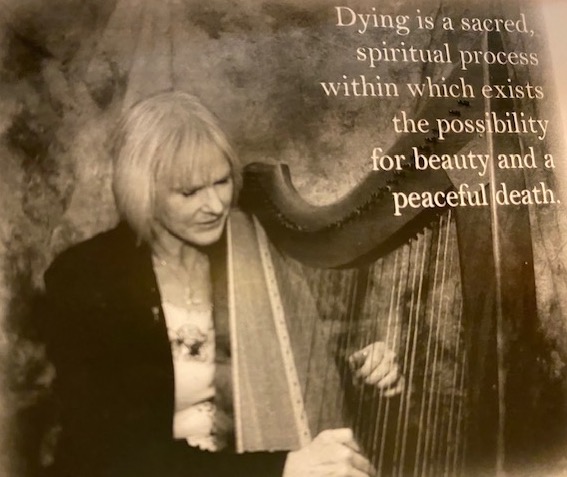Like anyone who has lost someone dear, I often think about the departure and how it might have been easier. My father died of the effects of Alzheimer’s in 2014 late one evening in the memory care unit where he’d been living. Family members were present. My mother died in 2020 just 13 days shy of her 100th birthday. She was in the process of dying for two days. But when she died, no family was present. I don’t know if she’d have known if we had been.
Their deaths came to mind
But both deaths came to my mind recently when certified music-thanatologists, Rebecca Hazlitt and Annie Burgard, came to the Universal Unitarian Fellowship I belong to. Their services are to provide harp music and voice at the bedside to offer special comfort at life’s end.
New to me
Perhaps like you, I’d not heard of such a service before. Rebecca is affiliated with a hospice program, and her business is called “Heart Wings–Where words fail, music speaks.”
MTAI
According to the Music-Thanatology Association International, music-thanatology is a professional field within the broader sub-specialty of palliative care. It is a musical/clinical modality that unites music and medicine in end of life care. The music-thanatologist utilizes harp and voice at the bedside to lovingly serve the physical, emotional and spiritual needs of the dying and their loved ones with prescriptive music.
Prescriptive music is live music that responds to the physiological needs of the patient moment by moment. For example, by observing vital signs such as heart rate, respiration and temperature, the music-thanatologist provides music that is tailored to each specific situation. The warmth of this living music can bring solace, dignity and grace to those nearing the ultimate journey at the end of life.
When is this used
The music vigil is used, according to Rebecca’s brochure,
–when the prognosis is terminal
–when there are no more medical options
–for patients experiencing physical or spiritual pain, agitation, sleeplessness, anxiety or dementia
–when no loved ones are present
–during family bedside gatherings
–during removal from life support
Helpful tips
It helps the thanatologist to know a bit about the patient’s background, to have a quiet setting with no interruptions and with limited coming and going in the room during the session. She also asks that the television and telephones be turned off and that routine medical activities be suspended for this time.
What to expect
What the family can expect during the vigil is:
–quiet prescriptive music especially for the patient and family
–periods of silence interspersed with music
–minimal and quiet conversation
–or, no verbal response at all
Average time
The average time is 30 to 60 minutes, after which the music-thanatologist departs silently.
Such services in your area?
I don’t know if such services are available in your area. But you might check if you’re in need of them. I know I would love to have offered this to both my father and mother. They were constantly on my mind as Rebecca and Annie spoke at my fellowship and played lovely harp music.

